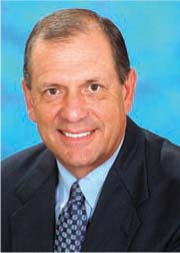All Issues
Focus on the future:
Publication Information
California Agriculture 63(3):106-106.
Published July 01, 2009
PDF | Citation | Permissions
Full text
Daniel M. Dooley UC Sr. Vice President, External Relations; Vice President, Agriculture and Natural Resources
Twelve months ago I wrote in this journal (July-September 2009, page 82) that California is changing rapidly. In describing the pressing issues facing our state, I noted that cutting-edge research, new technologies and practical information from the UC is solving many of these problems and making a real difference in the lives of Californians.
But I also challenged colleagues in UC and the Division of Agriculture and Natural Resources (ANR) to "prepare for the future as diligently as we have fostered progress in the past." This call to action was answered last summer with the appointment of a 10-person ANR strategic planning steering committee co-chaired by UC Regent Fred Ruiz and me.
The steering committee embarked on the first phase of a demand-driven, long-range planning process in August 2008 to engage the ANR community, our stakeholders and our partners in creating the comprehensive ANR Strategic Vision, which anticipates the complex challenges facing California through 2025, identifies where UC research and extension can make a difference, and analyzes our current capacity to address these priorities and challenges.
My expectations for completing phase one were extremely ambitious — produce a comprehensive strategic visioning document in under 9 months — but everyone in ANR stepped up to help us reach this goal. The first task was to commission five working groups, comprised of ANR academics, staff and external stakeholders. Their charge was to develop white papers assessing the future of the demographics and structure of California, agriculture and food systems, natural resource systems, health and human nutrition systems, and human development trends affecting youth, families and communities. The working groups drew on scientific literature and surveyed leaders in their respective issue areas to document what California would look like in 2025. An independent consultant surveyed opinion leaders on the major challenges and issues facing California and assessed their views of the university's strengths and weaknesses.
The white papers and surveys, completed in early December 2008, were synthesized into a draft strategic vision document by the ANR Program Council, which includes the executive associate deans from the four Agricultural Experiment Station colleges, Cooperative Extension regional directors and statewide program leaders. The steering committee reviewed the draft in late January 2009, then circulated it to external stakeholders and the ANR community over the next 2 months, which resulted in significant additional input.
In mid-April 2009 the final draft of the ANR Strategic Vision was approved by the steering committee. Later that month more than 600 ANR campus- and county-based academics and staff attended a statewide conference to review the visioning document and begin discussions around the creation of an implementation plan.
The strategic vision identifies nine multidisciplinary, integrated initiatives where UC research and extension has a high probability of making a real difference for Californians through providing the scientific and technological breakthroughs our residents will need to compete in a global economy; ensure a safe, nutritious food supply; conserve natural resources; and improve health outcomes. The initiatives focus on:
-
Improving water quality, quantity and security.
-
Enhancing competitive, sustainable food systems.
-
Increasing science literacy in natural resources, agriculture and nutrition.
-
Maintaining sustainable natural ecosystems.
-
Enhancing the health of Californians and California's agricultural economy.
-
Promoting healthy families and communities.
-
Ensuring safe and secure food supplies.
-
Managing endemic and invasive pests and diseases.
-
Improving energy security and green technologies.
When we began this process last summer, we anticipated taking another year to engage the ANR community and stakeholders in formulating next steps and developing an overarching strategy for implementing the ANR Strategic Vision. But these are unprecedented times for UC, California and the nation. The California Department of Finance projects a $24.5 billion shortfall in state general fund revenues for fiscal year 2009-10, and we will be accelerating our timelines to plan for inevitable cuts in state and county funding. Over the next few weeks we will be appointing ANR review teams to explore alternative models and options for maintaining UC Cooperative Extension-county partnership agreements; identify new opportunities for achieving greater efficiencies in statewide special programs, research and extension centers and other support units; and recommend administrative reductions.
Once we have addressed these budget cuts, I expect ANR to have a different look in terms of program delivery, support units and administration. While our strategic planning process will not make today's tough budget decisions any easier, we are fortunate to have taken steps to prepare for change through developing the ANR Strategic Vision and embarking on creation of an implementation plan.
With the ANR Strategic Vision in hand, which clearly states priorities and has broad support from the ANR community, we are positioned to take charge of our collective destiny. I am confident that our efforts will pay substantial dividends over the long term, both through increased support for UC and the recognition by university leaders and our growing base of stakeholders that ANR campus- and county-based programs are positive agents of change in an increasingly complex world.
For more information, go to http://ucanr.org/vision .





